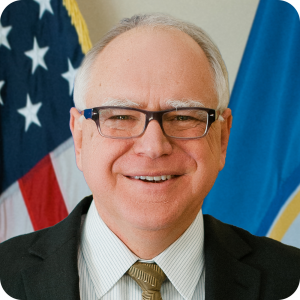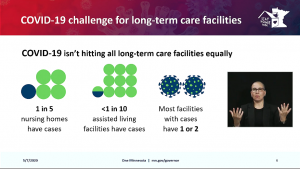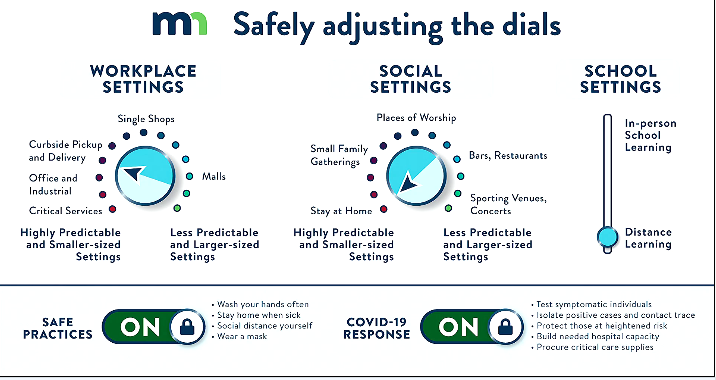5-7-2020 COVID-19 Update from MN Governor Walz and MDH
MN Governor Walz and the Minnesota Department of Health COVID-19 Update for 5-7-2020

Read a recap of yesterday’s update from the Minnesota Department of Health Here
On Thursday, May 7, 2020, Governor Tim Walz joined the Minnesota Department of Health and other state officials to provide an update on Minnesota’s response to COVID-19.
The following is a summary of Thursday’s media briefing.
Update from Governor Walz:
- MN reached a milestone of more than 500 deaths due to COVID-19
- Sympathies to the families of the people who have died
- One of the top discussion points among governors is that COVID-19 strikes the elderly, those with underlying health conditions, and people in congregate care facilities much harder.
- This virus, left unchecked, would run its course. But that doesn’t mean that we have to allow it to direct where it ends up. The actions that we’re taking can shift that away.
- We have a plan we want to implement on dealing with the long-term care facilities.
- We’re prepared “to go on the offensive”
- Expanded testing for residents in long-term care is part of it. What testing allows us to have a site picture so that we can isolate.
- The state is going to stock up our strategic state reserve of PPE.
- We’re gonna ensure adequate staffing levels in the hardest hit areas.
- This is a big weekend with Mother’s Day and the Fishing Opener. We want people to go fishing, but please do it smartly. Social distance and stay close to home.
- Thanks to the nurses who have been working hard throughout all of this.
Update from MDH Commissioner Jan Malcolm:
- Globally, 3.76 million cases of COVID-19 and 264,000 deaths
- In the U.S., there are 1.23 million cases and 73,400 deaths
- In MN, 9,365 cases (780 new cases since yesterday). We’re still building toward the peak. As we test more, we will find more.
- Minnesota’s doubling time is still at 8 days.
- There are now 508 deaths in Minnesota, an increase of 23 since yesterday.
- Today, 435 patients in Minnesota hospitals, 182 in intensive care.
- For black Minnesotans, their case rates are twice their proportion of the population and their hospitalizations are three times the rate of the population
- COVID-19 challenges for long-term care facilities
- America’s long-term care facilities face an elevated risk of COVID-19 outbreaks.
- residents are older and have more underlying medical conditions than the overall population
- congregate settings lead to closer contact with more people
- Pre-existing staffing challenges in the industry
- America’s long-term care facilities face an elevated risk of COVID-19 outbreaks.
- Residents of long-term care facilities account for
- less than 1 percent of Minnesota’s population
- 15 percent of Minnesota’s COVID-19 cases
- 80 percent of Minnesota’s COVID-19 deaths

- We know that the congregate care workforce has many people from the African immigrant community, and they are being disproportionately infected with COVID-19
- State currently works with facilities to help them prepare, prevent and respond
- MDH weekly briefing calls to share the latest updates and guidance
- When a case is confirmed, response teams move in to help with infection prevention, case interviews and contact tracing
- Each facility with outbreak gets MDH case manager to help them
- Critical situations get extra help to fix immediate crises and plan next steps
- Applying lessons of recent weeks
- We are building out or strategy to better support and protect residents and staff. Goals include:
- Preserving hospital bed capacity by ensuring long-term care facilities can safely accept and care for residents who don’t need to be in the hospital
- Reducing COVID-19 transmission among residents and staff
- Quickly identifying facilities needing special support
- Helping facilities plan for and manage COVID-19 infections
- Providing support for facilities to keep their staffing levels up
- Ensuring facilities can get PPE they need
- Training facility workers on resident care and infection prevention
- Building and maintaining enough bed capacity for residents with COVID-19 who do not need to be in the hospital
- We are building out or strategy to better support and protect residents and staff. Goals include:
- Minnesota’s Five-Point Battle Plan
- 1) Expand testing for residents and workers in long-term care facilities
- 2) Provide testing support and troubleshooting to clear barriers faster
- 3) Get PPE to facilities when needed
- 4) Ensure adequate staffing levels for even the hardest-hit facilities
- 5) Leverage our partnerships to better apply their skills and talents
- Point 1: Expand Testing
- Issue new guidance on testing, screening and monitoring, with requirements for long-term care facilities to:
- Institute consistent “active screening” practices for residents and staff
- Expand testing to all symptomatic residents and staff, as well as facility-wide testing when a case is confirmed or when multiple people develop symptoms
- Continue routine testing of residents/staff meeting specific risk criteria
- Amplify, expand and accelerate work on facilities’ action plans for COVID-19 cases among residents or staff, including steps for dealing with many cases
- Continue to ensure staff are trained on proper use of masks and other protective equipment
- Issue new guidance on testing, screening and monitoring, with requirements for long-term care facilities to:
- Point 2: Provide Testing Support & Troubleshooting
- Work with health systems to create “strike teams” that quickly conduct on-site testing and necessary follow up
- Coordinate with regional health care coalitions for immediate response and resources
- Coordinate with Testing Command Center to ensure testing supplies move efficiently where they are needed
- Point 3: Get Facilities Needed PPE
- Maintain state-managed cache of masks and other personal protective equipment for emergency use when a facility exhausts its supplies and is unable to restock
- Push out needed equipment for facilities facing outbreaks, and make it available to other facilities based on availability
- Point 4: Ensure Adequate Staffing
- Use the right mix of strategies to get staffing support to facilities in crisis. This may include:
- Establishing a fund and contracts to support “bridge staffing teams” of health care workers to provide temporary staffing
- Aggressively advocating for increased state and federal resources
- Activating the MN National Guard
- Using databases to “call out” health care workers that can take on-call shifts
- Using incentives to encourage health care systems to provide crisis staffing to facilities
- Use the right mix of strategies to get staffing support to facilities in crisis. This may include:
- Point 5: Leverage Partnerships
- Partner with local public health to coordinate support and provide on-site technical assistance to facilities
- Launch a new case management model at facilities, leveraging local public health and regional coalitions to provide guidance, monitoring and support
- Make sure that facilities maintain strong preparedness plans, including plans to reduce disease transmission and limit exposure risks
- Require facility commitment to reduce transmission by excluding ill workers and those testing positive, and by excluding workers with unprotected exposure.
- Metrics for Success
- Maintenance of low numbers of positive cases after an outbreak
- Reduction in the proportion of positive tests in LTC
- Onsite infection prevention support provided to LTC’s with even one COVID-19 case
- All skilled nursing facilities have updated preparedness plans for COVID-19
- All facilities are able to access staffing support without unnecessarily transferring residents to other sites for care
- Decrease in regulatory infection control citations below pre-pandemic levels
Additional notes from the media briefing:
- If long-term care facilities have a number of people test positive and they lose a significant portion of their workforce, Commissioner Malcolm says they plan to use the State Emergency Operations Center to mobilize large efforts quickly in a crisis situation. State workers are furloughed, and a lot of other people are out of work who might be willing to volunteer their time. The state will figure out a way to mobilize those people to go where they’re needed.
- Malcolm acknowledges the low pay and difficult work at some of these long-term care facilities.
- Malcolm says she’s unsure of the financial number needed from the state and federal government to ensure adequate staffing at long-term care facilities. Things under consideration are things like pay incentive, retention incentives, and hazard pay ideas. “Some of the funding could come from the existing COVID-19 fund, but as we say on so many of these topics, really to do this at scale and to deal with the legitimate needs around the whole state, it’s gonna take federal resources as well as state.”
- Governor Walz says one of the issues the state is having with testing is that, just because we have the capacity doesn’t mean that people are coming and getting tested.
- Commissioner Malcolm says the state didn’t fully anticipate the number of facilities that would need help. Their traditional process of swooping the experts in and having it centered on state health department expertise to do all the investigating and the coaching on infection control is not adequate to the task of being able to get out there quickly enough and to be thinking far out ahead enough. “It has taken us by surprise how many facilities will need, kind of, this level of enhanced help at the same time.”
- Commissioner Malcolm says the state will need to do a lot of training of the workforce to be able to provide the sensitive care that people need in congregate care settings.
- Governor Walz reiterates his request to ask people to stay close to home for the fishing opener and not to cross state lines. However, the state will not set up road blocks or any such thing.
- Governor Walz says Minnesota might be the last state to peak.
- In terms of re-starting professional sports, Governor Walz says “I think there’s some potential.” He encourages sports leagues to continue looking at ways to re-open. He would love to have a national strategy, although he says he’s not sure about having fans in the stands.
- In terms of the likelihood of the Twins playing in July, Governor says “I can’t imagine us playing Detroit if Michigan has 500,000 cases still raging and we’re up to 10,000 deaths across the upper Midwest, that’s difficult.”
- In terms of having socially-distanced outdoor graduations, the governor says “A graduation and a graduation party is one of the markings of adulthood. State “working hard” to provide guidance. Could release more details in coming week.
Current status of MN Governor’s safety dials to reopen the state:
Brooklyn Center | Brooklyn Park | Crystal | Golden Valley | Maple Grove | New Hope | Osseo | Plymouth | Robbinsdale


